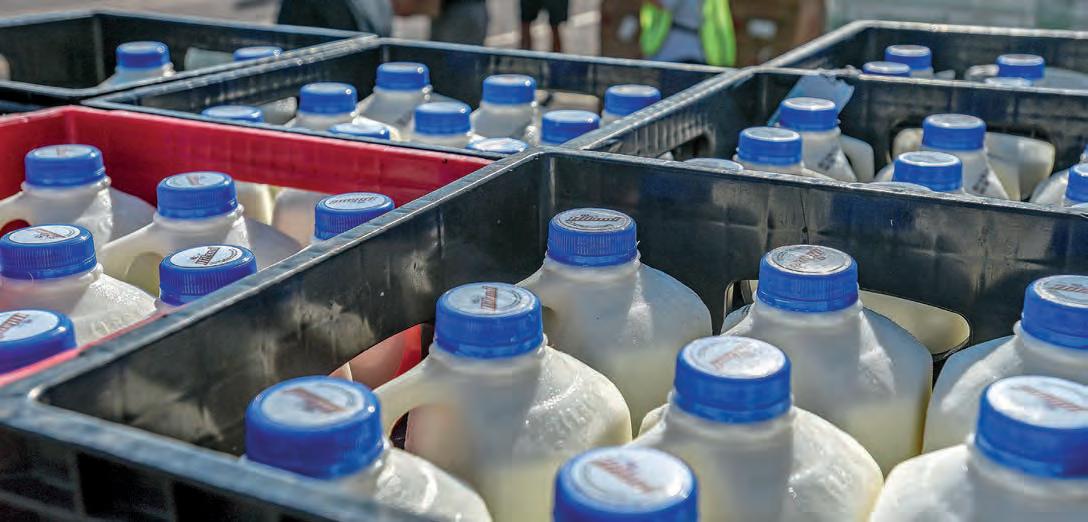
3 minute read
Plant-based beverages and cows
PLANT-BASED BEVERAGES CUTTING INTO SALE OF COW’S MILK, REPORT FINDS
By Johnathan Knutson | Forum News Service
Plant-based beverage alternatives are cutting into sales of cow’s milk, but aren’t a major factor in the long-standing decline in American consumption of traditional milk, according to a new report from the Economic Research Service, or ERS, an arm of the U.S. Department of Agriculture.
“Grocery store shelves and refrigerated cases offer a variety of nondairy beverages with package labels that include the word ‘milk.’ Industry statistics show almondbased products are the most popular. Also available are cashew, pea, soy and rice options, among others,” according to the report.
Further, “Sales of plant-based milk alternatives are contributing to — but not a primary driver of— declining sales of cow’s milk,” according to the report, which also found that “cow’s milk remains a staple food item.”
In 2013, American households consumed an average 0.4 gallons of fluid cow’s milk and 0.028 gallons of plantbased beverage per week. In 2017, the last year for which data was included in the ERS report, average household consumption per week stood at 0.359 gallons of cow’s milk, a 12% decline, and 0.038 gallons of plant-based beverage, a 36% increase.
The report’s findings are not unexpected, said Lucas Sjostrom, executive director of the Minnesota Milk Producers Association.
“I don’t think it’s a surprise as people get more (shopping) choices,” he said. Unfortunately, some consumers mistakenly believe that nondairy products with “milk” on the label “is the same stuff” as dairy.
“These alternatives are here to stay, (although) we would prefer them not calling themselves milk. They’re definitely a viable competitor, but so is bottled water, soda and many other things,” said Sjostrom, a dairy farmer himself.
He noted that consumers “buying plant-based products are doing so based on health, special diet and environmental concerns.” In contrast, consumers purchase dairy for “reasons such as flavor, texture, quality, familiarity, affordability and health.”
“It is important to note that health is less of a purchase driver when comparing milk buyers to plant-based buyers,” Sjosrom said.
He cited a recent survey with data on consumers who buy either dairy milk or plant-based beverages, but not both. In the survey, 56.4% of respondents said cow’s milk was a “habitual purchase” and 53.7% said “they like the taste” of cow’s milk, Lucas Sjostrom while 33.3% said they bought plantbased beverages as part of a vegan diet and 30.4% said they bought alternatives because of allergies/sensitivities.
Though Americans have been drinking less fluid cow’s milk on a per-person basis since the 1940s, the rate of decline has risen in recent years, partly the result of plant-based alternatives. Between 1995 and 2009, ERS data show that the per-person U.S. supply of cow’s milk available for consumption fell at an average annual rate of 1%. From 2010 to 2017, per capita availability fell at an average rate of almost 2.5% a year, according to the report.
Nonetheless, cow’s milk remains common in Americans’ diets. In 2017, 92% of American households bought it, and even 90% of households that bought plant-based alternatives also bought cow’s milk, the report found.
Other dairy products
Though cow’s milk sales are slipping, “I don’t feel we’re anywhere near falling off a cliff,” Sjostrom said.
About 340 million gallons of plant-based alternatives are consumed annually, while about 3.2 billion gallons of cow’s milk are consumed, he said.
Because the plant-based alternatives started off with relatively low sales, even a modest increase in consumption of them leads to a relatively large percentage increase in sales, he said.
“You can gain a lot of market share on a percentage basis when you’re starting at low numbers,” he said.

Consumption milk continues to decline, but the decline is only partially due to increases in consumption of plant-based beverages.
Matt Gade / Forum News Service
Though many Americans are drinking less milk, “They’re eating it through cheese and other items,” he said. “For us as dairy farmers and those who work for dairy farmers, it’s going to be the total volume and the value of that volume rather than just an individual product (milk).”
At the same time, the milk industry continues to look for ways to innovate and boost fluid milk consumption, he said.









